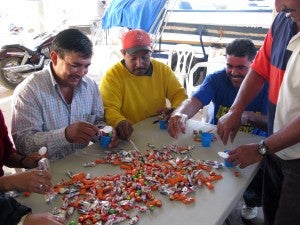EDF’s Fishing Game Highlighted on RARE Blog
Originally posted in Rare Dispatches, Author: J.M. McCord

Ulises Mendez, Rare program manager in Mexico, waited for the cackles to subside before asking the fishers what they had learned. The fishers had just completed a candy-grabbing game designed to expose the benefits of good fishery management.
Environmental Defense Fund (EDF) first exposed Mendez to the game during a workshop a couple years ago. Many versions of the game exist involving a variety of props and customizations. The essential elements are:
1 A proxy for the ocean — “In our regional training we did the fishing game in a pool,” says Sarilani Wirawan, Rare senior program manager in Indonesia. “The more water, the more fun.” Typically, a table will do.
2 Fish stand-ins — any material available will suffice, ranging from rocks, peanuts and shells to goldfish cut-outs or action figures, but the most popular option is candy. Mendez used multi-colored candy to represent different types of fish such as juveniles and adults.
3 Some versions also include props for different fishing gear or plates for no-fishing areas. The specifics can be tweaked for relevance to a region’s laws and threats.
“Participants always learn new insights into sustainable fisheries management, fisheries economics or the fishing industry in general.” -Ashley Apel of EDF.
In Loreto, Mexico, Mendez had fishers use spoons and tongs for nets and hook-and-line fishing because those are their primary fishing methods. Many of Rare’s projects on sustainable fishing, including those managed by Mendez, use the game to highlight how working together and different management tools increase long-term benefits for fishers.
Mendez took the Loreto fishers through three rounds of the game:
Round 1 Anarchy — in a fixed amount of time, say 60 seconds, fishers had open access to candy (fish) on the table (ocean). They emptied the ocean very quickly.
Round 2 One Management tool — for example, the fishers could only take adult fish and were fined, in candy payments, for taking juveniles.
Round 3 Rights and reserves — the rules are adapted for additional management layers such as user rights and no-fishing zones. Essentially, Mendez tweaked the rules so fishers created a candy-land territorial user right for fisheries with a no-fishing zone (TURF-reserve).
The game got a huge laugh out of the salt-stained and sun-weathered men. Even though they are savvy fishers and know the consequences of overfishing, they could not believe they hoarded all the candy. “Participants always learn new insights into sustainable fisheries management, fisheries economics or the fishing industry in general,” says Ashley Apel of EDF.
Mendez discovered that fishers who play the game conclude they should play a role in enforcement. Fishers do not need to depend on authorities, rather they can apply sanctions internally against their fishing cooperative members who do not follow the rules of “Go Fish!”










